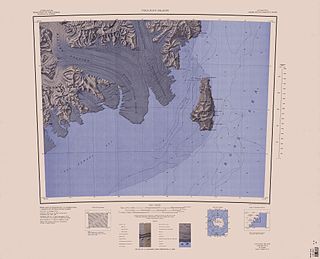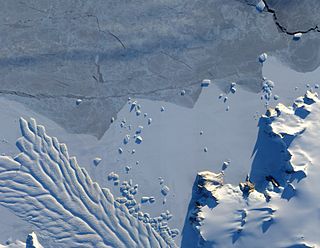The Queen Elizabeth Range is a rugged mountain range of the Transantarctic Mountains System, located in the Ross Dependency region of Antarctica.

Lillie Glacier is a large glacier in Antarctica, about 100 nautical miles (190 km) long and 10 nautical miles (19 km) wide. It lies between the Bowers Mountains on the west and the Concord Mountains and Anare Mountains on the east, flowing to Ob' Bay on the coast and forming the Lillie Glacier Tongue.

Borchgrevink Glacier is a large glacier in the Victory Mountains, Victoria Land, draining south between Malta Plateau and Daniell Peninsula, and thence projecting into Glacier Strait, Ross Sea, as a floating glacier tongue, the Borchgrevink Glacier Tongue, just south of Cape Jones. It was named by the New Zealand Geological Survey Antarctic Expedition, 1957–58, for Carsten Borchgrevink, leader of the British Antarctic Expedition, 1898–1900. Borchgrevink visited the area in February 1900 and first observed the seaward portion of the glacier.


The LeMay Range is a mountain range 40 nautical miles (70 km) long with peaks rising to 2,000 metres (6,600 ft), extending in a northwest–southeast direction from Snick Pass to the north side of Uranus Glacier in the central portion of Alexander Island, Antarctica. It was first seen from the air by Lincoln Ellsworth on November 23, 1935, and the north and east portions mapped from photos obtained on that flight by W.L.G. Joerg. Later, it was resighted from the air by the Ronne Antarctic Research Expedition (RARE), 1947–48, and named by Finn Ronne for General Curtis LeMay, Deputy Chief of Air Staff for Research and Development of the then United States Army Air Forces, which furnished equipment for the expedition. The range was remapped in detail from RARE photos by D. Searle of the Falkland Islands Dependencies Survey in 1960.
The Airy Glacier is a glacier 20 nautical miles (37 km) long and 6 nautical miles (11 km) wide, flowing west to the northeast portion of Forster Ice Piedmont, near the west coast of the Antarctic Peninsula.
Explorers Range is a large mountain range in the Bowers Mountains of Victoria Land, Antarctica, extending from Mount Bruce in the north to Carryer Glacier and McLin Glacier in the south. Named by the New Zealand Antarctic Place-Names Committee (NZ-APC) for the northern party of New Zealand Geological Survey Antarctic Expedition (NZGSAE), 1963–64, whose members carried out a topographical and geological survey of the area. The names of several party members are assigned to features in and about this range. All of the geographical features listed below lie situated on the Pennell Coast, a portion of Antarctica lying between Cape Williams and Cape Adare.
Bartók Glacier is a glacier, 7 nautical miles (13 km) long and 3 nautical miles (6 km) wide, flowing southwest from the southern end of the Elgar Uplands in the northern part of Alexander Island. It was first photographed from the air and roughly mapped by the British Graham Land Expedition in 1937, and more accurately mapped from air photos taken by the Ronne Antarctic Research Expedition, 1947–48, by D. Searle of the Falkland Islands Dependencies Survey in 1960. It was named by the UK Antarctic Place-Names Committee after the Hungarian composer Béla Bartók.
Delius Glacier is a glacier, 6 nautical miles (11 km) long and 2 nautical miles (4 km) wide, flowing west from the Elgar Uplands into Nichols Snowfield, in the northern part of Alexander Island, Antarctica. It was first seen from the air and roughly mapped by the British Graham Land Expedition in 1937. It was more accurately mapped from air photos taken by the Ronne Antarctic Research Expedition, 1947–48, by D. Searle of the Falkland Islands Dependencies Survey in 1960, and from U.S. Landsat imagery of February 1975. It was named by the UK Antarctic Place-Names Committee after Frederick Delius, the British composer.
Grimley Glacier is a tributary glacier, 15 nautical miles (28 km) long and 3 nautical miles (6 km) wide, lying 3 nautical miles north of Sunfix Glacier and flowing east-northeast into Casey Glacier in northern Palmer Land, Antarctica. The glacier was photographed from the air by the United States Antarctic Service on September 28, 1940, and by the Ronne Antarctic Research Expedition on December 22, 1947. It was surveyed by the Falkland Islands Dependencies Survey (FIDS) in December 1960 and was named by the UK Antarctic Place-Names Committee for Peter H. Grimley of FIDS, a geologist at Horseshoe Island and Stonington Island in 1960.

Matusevich Glacier is a broad glacier about 50 nautical miles (90 km) long, with a well developed glacier tongue, flowing to the coast of East Antarctica between the Lazarev Mountains and the northwestern extremity of the Wilson Hills.
Palestrina Glacier is a glacier lying in the northern portion of Alexander Island, Antarctica, 11 nautical miles (20 km) long and 8 nautical miles (15 km) wide, flowing west from Nichols Snowfield into Lazarev Bay. The glacier was mapped from air photos taken by the Ronne Antarctic Research Expedition (RARE), 1947–48, by Derek J.H. Searle of the Falkland Islands Dependencies Survey (FIDS) in 1960. Named by the United Kingdom Antarctic Place-Names Committee (UK-APC) for Giovanni da Palestrina (1525–1594), Italian composer.
Pearson Spur is a spur extending southeast from Elgar Uplands toward the head of Sibelius Glacier, situated in the northern portion of Alexander Island, Antarctica. Photographed from the air by Ronne Antarctic Research Expedition (RARE) in 1947, roughly mapped from air photographs by Falkland Islands Dependencies Survey (FIDS) in 1959, and surveyed by British Antarctic Survey (BAS), 1973–77. Named by United Kingdom Antarctic Place-Names Committee (UK-APC) in 1980 after Martin Robert Pearson, BAS glaciologist, 1970–73, who worked on Alexander Island, in years 1971 and 1972.
The Finlandia Foothills are a rock massif, 10 nautical miles (19 km) long and 3 nautical miles (6 km) wide, rising to about 1,130 metres (3,700 ft) at the west side of Sibelius Glacier, situated in northern Alexander Island, Antarctica. The massif lies immediately south of the Geode Nunataks, north of the Handel Ice Piedmont and west of Witches Cauldron. They were photographed from the air by the Ronne Antarctic Research Expedition, 1947–48, and mapped from these photographs by D. Searle of the Falkland Islands Dependencies Survey, 1960. In association with the glacier they were named after the symphonic poem Finlandia by the Finnish composer Jean Sibelius (1865-1957).

The Moran Glacier is a glacier 10 nautical miles (18 km) long, joined at the south side by Walter Glacier, flowing east into Schokalsky Bay, in the northeast portion of Alexander Island, Antarctica. Photographed from the air by Ronne Antarctic Research Expedition (RARE), 1947–48, and surveyed by Falkland Islands Dependencies Survey (FIDS), 1948–50. Named by Advisory Committee on Antarctic Names (US-ACAN) for Commander Clifford D. Moran, U.S. Navy, aircraft pilot, Squadron VXE-6, U.S. Navy Operation Deep Freeze, 1966 and 1977.
Matheson Glacier is a glacier 11 nautical miles (20 km) long, lying 2 nautical miles (4 km) south of Ashton Glacier, which it parallels, and flowing in an easterly direction to the west side of Lehrke Inlet, on the east coast of Palmer Land, Antarctica. It was first sighted by members of the United States Antarctic Service who explored this coast by land and from the air in December 1940, and was first charted by a joint party consisting of members of the Ronne Antarctic Research Expedition and Falkland Islands Dependencies Survey (FIDS) in 1947. The glacier was named by the FIDS for J. Matheson, a member of the FIDS at the Port Lockroy and Hope Bay bases, 1944–46.

Schokalsky Bay is the easternmost bay of Alexander Island, Antarctica, 9 nautical miles (17 km) wide at its entrance and indenting 6 nautical miles (11 km) lying between Mount Calais and Cape Brown along the east coast of Alexander Island whilst adjacent to the George VI Ice Shelf in George VI Sound. Hampton Glacier discharges tremendous amounts of ice into the head of Schokalsky Bay at a steep gradient causing the ice there to be extremely broken and irregular, and discourages use of this bay and glacier as an inland sledging route onto northeast Alexander Island. The bay was first sighted from a distance in 1909 and roughly charted by the French Antarctic Expedition under Charcot who, thinking it to be a strait, gave the name "Detroit Schokalsky" after Yuly Shokalsky, a Russian geographer, meteorologist and oceanographer. Charcot followed the spelling Schokalsky used by the man himself when writing in Roman script. The coast in this vicinity was photographed from the air and this bay roughly charted in 1937 by the British Graham Land Expedition, but Charcot's "Detroit Schokalsky" was not identified. Surveys by Falkland Islands Dependencies Survey in 1948 identified this bay as the feature originally named by Charcot.
Chapman Glacier is a glacier 11 miles (18 km) long and 10 miles (16 km) wide in its central part, narrowing to 3 miles (5 km) at its mouth, flowing west from the Dyer Plateau of Palmer Land to George VI Sound immediately south of Carse Point. It was first surveyed in 1936 by the British Graham Land Expedition (BGLE) under John Rymill, and named by the UK Antarctic Place-names Committee in 1954 for Frederick S. Chapman, British mountaineer and Arctic explorer, who in 1934 brought 64 dogs from West Greenland to England for the use of the BGLE, 1934–37.
![]() This article incorporates public domain material from "Sibelius Glacier". Geographic Names Information System . United States Geological Survey.
This article incorporates public domain material from "Sibelius Glacier". Geographic Names Information System . United States Geological Survey. ![]()





